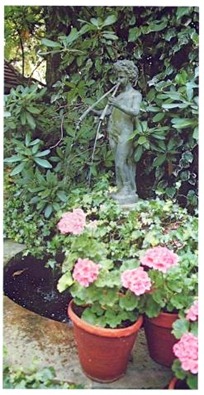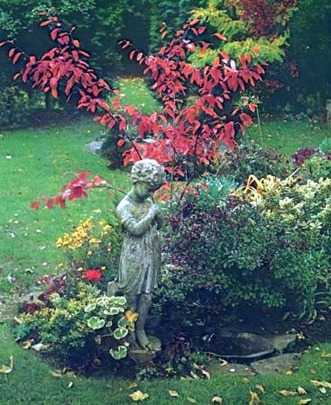





Many of the great gardens of the past depended upon inanimate ornaments for much of their effect. In Europe this began as an Italian renaissance idea repeating, as it was thought, the great periods of classical learning and art a thousand years before. Hence statuary representing myths, gods and idealised humans stood about to give point to a vista, to line a terrace and generally to emphasise the fact that a garden was something of a paradise.
As the centre of European culture moved north into France and later into England, the statues, urns, obelisks and pillars continued to be used as focal points in very different situations. They exist in profusion in the daunting formality of I 7th century Vaux-le-Vicomte and Versailles, and with greater restraint at 18th century Stowe and Stourhead, both epitomes of the English landscape garden. One common factor links these garden ornaments: they were invariably works of art in their own right (it does help here to be the greatest monarch that France ever had or one of England’s most prosperous bankers, to be able to pay for such things).
However, those of us who by chance are neither royal nor rich, can still profitably look to success of the past in using the inanimate in the garden scene.
 The objects and the material from which they are made can vary enormously, but a few considerations can help towards their choice and use. Roles are in particular twofold: to emphasise or give permanent interest to a spot where plants alone cannot quite suffice, and to take the eye and hold it at the end of a viewing-point. ‘Vista’ may seem too extravagent a word when the eye-catcher (a good 18th-century landscaper’s term) is only a few feet away. However, it is valid and as important as the sham castle built on a hill in the next county was in a previous century. Whatever it is, it must add to the garden picture, it must be in scale with its surroundings and must be as good of its type as can be found. A deep pocket is desirable but not essential. Nowadays, to find a piece of old statuary or an elegant urn at an acceptable price is most unlikely. Fortunately reproductions in reconstituted stone or glass fibre are often very good (though not all) and can be helped to join in with the garden scene by judicious planting. An occasional spray with liquid manure will encourage mosses and algae and give a feeling of age.
The objects and the material from which they are made can vary enormously, but a few considerations can help towards their choice and use. Roles are in particular twofold: to emphasise or give permanent interest to a spot where plants alone cannot quite suffice, and to take the eye and hold it at the end of a viewing-point. ‘Vista’ may seem too extravagent a word when the eye-catcher (a good 18th-century landscaper’s term) is only a few feet away. However, it is valid and as important as the sham castle built on a hill in the next county was in a previous century. Whatever it is, it must add to the garden picture, it must be in scale with its surroundings and must be as good of its type as can be found. A deep pocket is desirable but not essential. Nowadays, to find a piece of old statuary or an elegant urn at an acceptable price is most unlikely. Fortunately reproductions in reconstituted stone or glass fibre are often very good (though not all) and can be helped to join in with the garden scene by judicious planting. An occasional spray with liquid manure will encourage mosses and algae and give a feeling of age.
In a small area a big spot, raised on bricks perhaps, a plant-filled chimney pot, an interesting dead tree bole or a big piece of sea-washed timber can do the job admirably. Sundials and bird baths are popular and can be admirable. Unfortunately those on general garden-centre sale are apt to lean heavily towards the visually banal, often with soap-opera captions to match about ‘kisses of sun for pardon’ and gardens being ‘love-some things’ — in fact the whole gamut of that which has been admirably described as ‘Godwottery’. Perhaps the most satisfactory sundial lines are by Hilaire Belloc:
‘I am a sundial
And I make a botch
Of what is done
Far better by a watch.’
 More important, and apparently obvious, is that a sundial is a nonsense if placed in the shade. Similarly bird baths are no use if positioned in an awkward position for watching the avian visitors.
More important, and apparently obvious, is that a sundial is a nonsense if placed in the shade. Similarly bird baths are no use if positioned in an awkward position for watching the avian visitors.
Snow White, her seven dwarfs and all related gnomes are best left in Disneyland, whence they came. In the garden, coyly placed around the pond where they are quite clearly paying no attention to the equally twee ‘No Fishing’ notice, they may be amusing to begin with but the joke quickly palls.
However, whatever the owner’s proclivities in this line—and a garden after all is a place where wishes and likes can be indulged regardless of precious pundits — the fact that some object is obtained and sited indicates its importance in the garden scene. And one area where we gain over grand gardeners of earlier times is our ability to enjoy these things at night by modern lighting techniques. Where a view is part of a lived-in room as well as outdoor garden it is admirable to emphasise it by a spot-light.
Similarly if a terrace or other sitting out area is to be used to the full, lighting is well worth considering. Electricity can easily be taken either above or below ground to the requisite spot by a professional electrician to avoid danger and ultimately probably save cost.
The range of light holders is now considerable and as with statuary, choice of design is a matter of personal likes or dislikes. Only one thing perhaps should be said: the whole object of the exercise is to enhance the night, in the daytime the holders should be as unnoticeable as possible.
Copyright © www.100flowers.win Botanic Garden All Rights Reserved